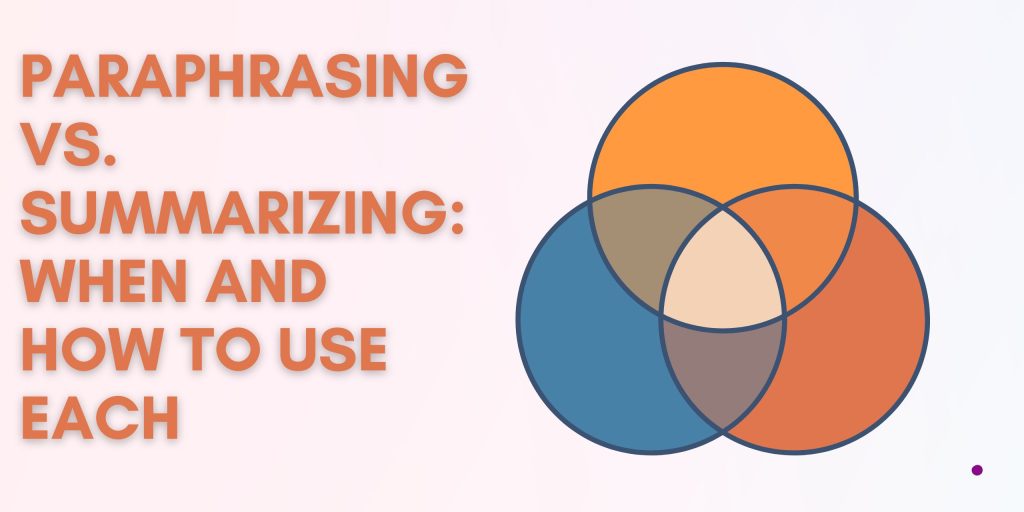In the realm of academic writing, paraphrasing and summarizing are two essential skills that allow writers to incorporate information from external sources. While both techniques involve restating someone else’s ideas in your own words, they serve different purposes and are employed in different contexts. In this blog post, we will explore the distinctions between paraphrasing and summarizing, discuss when to use each technique, and provide real-life examples to illustrate their application.
Paraphrasing: Explaining Ideas in Your Own Words
Paraphrasing involves restating someone else’s ideas or information in your own words while maintaining the original meaning. When you paraphrase, you provide a detailed explanation or rephrasing of the source material, capturing the essence of the original text without directly quoting it. Paraphrasing is often used when you want to delve into a specific idea, explore nuances, or provide additional context.
Example of Paraphrasing:
Original sentence: “The rise of social media has revolutionized communication, enabling people from different parts of the world to connect instantly and share ideas.”
Paraphrased sentence: “The emergence of social media platforms has transformed the way people communicate, allowing individuals from diverse geographical locations to connect immediately and exchange thoughts.”
In this example, the original sentence is paraphrased by rephrasing the language, altering the sentence structure, and using different vocabulary while maintaining the main idea.
When to Use Paraphrasing:
- When you want to provide an in-depth analysis or explanation of a specific concept or idea.
- When you need to clarify complex or technical information by expressing it in simpler terms.
- When you want to integrate the ideas of multiple sources into a cohesive narrative.
Summarizing: Condensing Information to the Main Points
Summarizing involves condensing a longer piece of text into a shorter version that captures the main points or central ideas. When you summarize, you distill the key information, omitting irrelevant details and examples. Summaries provide readers with an overview of the original text, allowing them to grasp the main ideas without having to read the entire source material.
Example of Summarizing:
Original paragraph: “The Industrial Revolution, which took place in the 18th and 19th centuries, marked a significant shift in human history. It was characterized by the transition from hand production methods to machine-based manufacturing, resulting in increased productivity, urbanization, and profound social and economic changes.”
Summary: The Industrial Revolution, occurring in the 18th and 19th centuries, transformed society through the adoption of machine-based manufacturing, leading to improved productivity, urbanization, and far-reaching social and economic transformations.
In this example, the original paragraph is summarized by condensing the information to the main points, capturing the essence of the Industrial Revolution without including specific details.
When to Use Summarizing:
- When you want to provide a concise overview of a longer text, such as a research article or a book.
- When you need to present a brief summary of multiple sources to provide an overview of a topic.
- When you want to emphasize the main ideas or arguments of a text while omitting specific details or examples.
Guidelines for Effective Paraphrasing and Summarizing:
- Understand the source material: Before attempting to paraphrase or summarize, make sure you thoroughly understand the original text. Identify the main ideas, supporting evidence, and any key details.
- Capture the essence: When paraphrasing, strive to maintain the original meaning while expressing it in your own words. When summarizing, focus on condensing the information to the main points without distorting the central ideas.
- Alter sentence structure and vocabulary: For paraphrasing, rephrase sentences using different structures and vocabulary. For summarizing, condense the information by eliminating unnecessary details and examples.
- Use citation and attribution: Both paraphrasing and summarizing require proper citation and attribution to acknowledge the original source. Follow the appropriate citation style guidelines (e.g., APA, MLA) to give credit to the original author.
- Revise and refine: After paraphrasing or summarizing, review your work to ensure clarity, coherence, and accuracy. Make necessary revisions to improve the flow of your writing and ensure that your paraphrased or summarized content fits seamlessly into your own work.
Conclusion:
Paraphrasing and summarizing are valuable skills in academic writing, allowing you to incorporate information from external sources while maintaining your own voice and perspective. Paraphrasing involves restating ideas in your own words to provide a detailed explanation, while summarizing condenses longer texts to capture the main points. By understanding the distinctions between paraphrasing and summarizing and knowing when to use each technique, you can effectively integrate external information into your writing. Remember to provide proper attribution, alter sentence structure and vocabulary, and revise your work for clarity and coherence. With practice, you will master these skills and enhance the quality and credibility of your academic writing.
